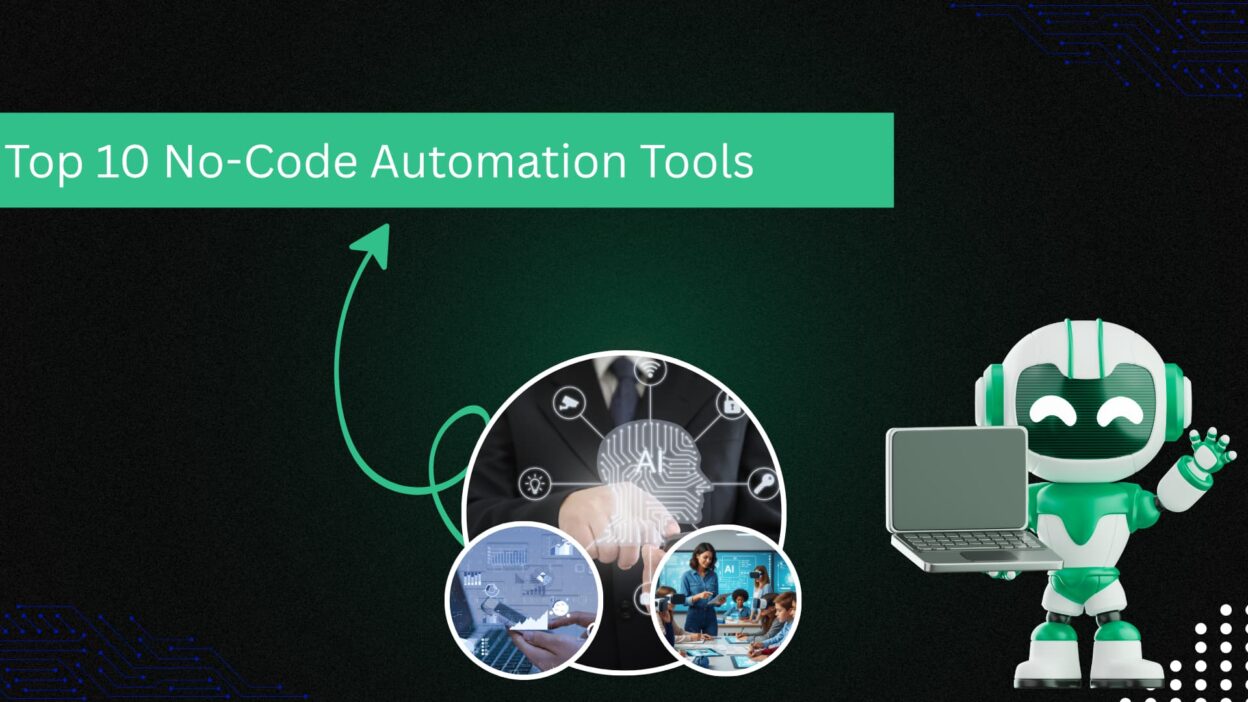No-code automation has moved from “nice to have” to core infrastructure for modern teams. Whether you’re a solo founder, a growth marketer, or an operations lead in an enterprise, no-code platforms let you stitch apps together, automate repetitive work, and build lightweight agents — all without writing production code.
Below are the top 10 no-code automation tools in 2025, with practical detail on what each does best, who should use it, common use cases, and tips for getting started.
1. Zapier
What it is: Zapier popularized the “trigger → action” automation model and remains the most broadly connected platform, with thousands of app integrations and an interface built specifically for non-developers. It’s excellent for getting quick wins and automating cross-app workflows.
Strengths: massive app ecosystem (ideal when you need an integration that “just works”), very low learning curve, solid templates, and good reliability for small to mid workloads.
Best for: SMBs, marketers, customer-support teams, and founders who want fast automations without engineering time.
Example use cases: new-lead enrichment (CRM + email + slack notifications), daily report snapshots, multi-step onboarding sequences that update several apps.
Tip: start with premade “Zaps,” then add filters and multi-step logic as you grow. Watch task volume — cost scales with run counts.
2. Make
What it is: Make provides a visual canvas for building complex workflows (including branching, iterators, and advanced data transforms) and has invested heavily in AI/agent capabilities. It’s more visual and expressive than most drag-and-drop tools, letting you model sophisticated logic without code.
Strengths: strong data manipulation, visual debugging, and the ability to orchestrate multi-step, conditional automations at scale.
Best for: ops teams, product managers, and technically savvy non-engineers who need expressive workflows.
Example use cases: ETL-like transfers between systems, automated invoice processing with conditional routing, AI-assisted ticket triage.
Tip: use Make’s visual log to debug flows step-by-step; it makes fault finding much faster than reading dense logs.
3. Microsoft Power Automate
What it is: Power Automate integrates tightly with Microsoft 365, Azure, and enterprise systems, and in 2025 its roadmap is AI-first — adding multimodal and self-healing automations for complex business processes. If your org runs on Microsoft tech, this is the natural automation layer.
Strengths: enterprise governance, desktop automation (RPA), deep connectors into Microsoft services, and ROI/observability features for large deployments.
Best for: mid-to-large enterprises that need compliance, visibility, and integration with Microsoft stacks.
Example use cases: automated invoice approvals using SharePoint + Teams routing, desktop RPA for legacy systems, and document processing with AI.
Tip: pair Power Automate with Center of Excellence (CoE) tooling to manage citizen developers and maintain control over automation sprawl.
4. Workato
What it is: Workato positions itself as an enterprise orchestration and agentic automation platform. It’s focused on secure, large-scale integrations and has recently added features for trading-partner orchestration and EDI modernization. It’s geared for organizations that need robust, audited orchestration across many systems.
Strengths: enterprise-grade security, robust transformation capabilities, and strong support for complex business processes and partner integrations.
Best for: companies with complex ERP/CRM integrations, supply-chain orchestration, and regulated industries.
Example use cases: end-to-end order orchestration across ERP, fulfillment, and logistics; automated partner onboarding and EDI flows.
Tip: treat Workato as strategic infrastructure — invest time in design and reuse of “recipes” (reusable workflows).
5. n8n
What it is: n8n is an open-source workflow automation tool that gives teams the freedom to self-host, extend nodes, and customize behavior beyond the constraints of SaaS rules. It’s perfect when you need no-code ease plus developer extensibility.
Strengths: self-hosting option, code nodes for custom logic when necessary, and a developer-friendly model under an open license.
Best for: engineering teams that want control over data, startups with privacy needs, and teams that mix non-technical automation builders with dev oversight.
Example use cases: internal data pipelines, secure automations where data residency matters, and complex routing with custom nodes.
Tip: if you self-host, treat it like any other infra — monitor uptime and secure access tokens carefully.
6. IFTTT
What it is: IFTTT (If This Then That) focuses on simple automations and especially on consumer and Internet-of-Things integrations. It’s the fastest way to automate simple triggers across everyday apps and smart devices.
Strengths: unbelievably easy setup, strong IoT/consumer device ecosystem, and a simple rules model.
Best for: home automation, social automations, and small teams wanting quick personal-productivity shortcuts.
Example use cases: posting across social channels automatically, “if a sensor detects X, then alert on slack,” or syncing simple feeds.
Tip: use IFTTT for lightweight tasks; for business-critical workflows look to Zapier or Make.
7. Pabbly Connect
What it is: Pabbly Connect offers Zapier-style automation at aggressive pricing, with many common connectors and a straightforward drag-and-drop workflow builder. It’s increasingly popular for teams who need the functionality of mainstream platforms but with tighter budgets.
Strengths: cost efficiency, easy onboarding, and built-in tools like email parsers and iterators.
Best for: startups, SMBs, and freelancers who need automation without the premium pricing.
Example use cases: multi-app lead routing, automated invoicing, and e-commerce order workflows.
Tip: carefully test edge cases like rate limits and error handling — lower price points sometimes mean more manual tuning.
8. Parabola
What it is: Parabola is a no-code data-automation builder focused on transforming and moving messy data (CSV, spreadsheets, APIs) with an intuitive flow interface. It’s like a spreadsheet on steroids for automation.
Strengths: excellent for ETL-style tasks, scheduled jobs, and when you need to clean/transform datasets without writing SQL or scripts.
Best for: operations teams, finance, and growth teams that run recurring data processes (reporting, enrichment, customer segmentation).
Example use cases: nightly data sync from Shopify → analytics warehouse, automated lead cleaning and enrichment, PDF or email parsing to structured data.
Tip: map out data schemas before building flows — Parabola lets you preview transforms which prevents surprises in production.
9. Tray.io
What it is: Tray.io offers a visual automation and integration platform that targets mid-market and enterprise users who need programmatic power without full-time integration engineering. It balances no-code low-code features with enterprise reliability.
Strengths: strong API support, flexible connectors, and build-time debugging for complex integrations.
Best for: product/ops teams building integrations into their product or internal systems, companies scaling beyond simple point-to-point automations.
Example use cases: syncing product usage data into marketing automation, back-office orchestration for SaaS billing, or custom integrations for enterprise customers.
Tip: leverage Tray’s templating and modular workflows to keep logic maintainable as automations expand.
10. Airtable
What it is: Airtable combines a spreadsheet-database UI with built-in automations and scripting blocks. Its Automations feature is great for teams that already store processes in Airtable and want in-place triggers and actions (email, Slack, webhook, record updates).
Strengths: tight coupling of data + automation (no external system required), good for lightweight process automation, and excellent UX for non-technical teams.
Best for: small product teams, creatives, and business ops that already use Airtable as a system of record.
Example use cases: content-publishing pipelines, candidate tracking with auto-emails, and inventory alerts.
Tip: use Airtable Automations to prototype; when workflows outgrow table triggers, connect to Make or Zapier for more orchestration.
How to pick the right tool
- Data gravity: where does your data live? If it’s mostly in Microsoft 365, pick Power Automate. If it’s in Airtable, start with Airtable Automations.
- Complexity vs speed: Zapier/IFTTT = speed; Make/Workato/Tray = complexity and scale.
- Budget: Pabbly and n8n self-host are cost-sensitive options.
- Governance & compliance: enterprises should prefer platforms with strong auditing and SSO (Workato, Power Automate, Tray).
- Extensibility: need custom code? n8n or platforms with custom nodes/hooks are better.
- Failover & observability: for business-critical flows choose platforms that offer logs, retries, and monitoring.
Final tips for success
- Start small: automate one repeatable task; measure time saved and reliability before expanding.
- Design for errors: add alerts and retries; automations should fail loudly (and safely).
- Document flows: treat automations like code — version their logic in a central place.
- Govern citizen automation: empower teams but enforce naming, tagging, and owner fields so automations don’t become mysterious background processes.
- Measure impact: capture ROI (hours saved, error reduction) to justify scaling automation investment.




